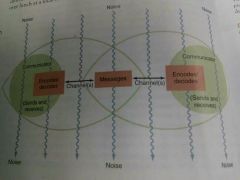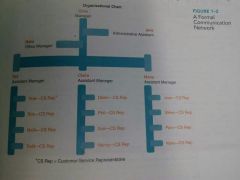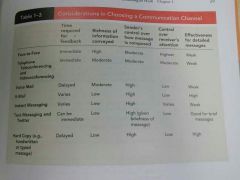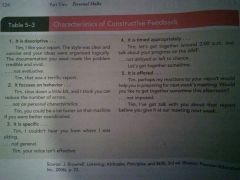![]()
![]()
![]()
Use LEFT and RIGHT arrow keys to navigate between flashcards;
Use UP and DOWN arrow keys to flip the card;
H to show hint;
A reads text to speech;
28 Cards in this Set
- Front
- Back
- 3rd side (hint)
|
Ch. 1 Top qualities in an employee |
Communication skills, strong work ethic, teamwork skills |
Table 1-1 |
|
|
Ch. 1 Communication |
The process of creating meaning through symbolic interaction. |
Memorize this OR ELSE |
|
|
Ch. 1 Communication model components |

Communicator, receiver, message, decoding/encoding process, channel, noise |
Draw it out to help remember (fig 1-1) |
|
|
Ch. 1 Methods of communication |
Verbal, nonverbal, downward, upward, horizontal (last three specific to networks) |
How and to whom |
|
|
Ch. 1 Medium (i.e. channels, methods) |
Face to face, telephone, instant message/texting, letter, email, twitter |
Think of as many ways as possible you could encode a message |
|
|
Ch. 1 Types of media |
Social media, radio, television, blog, twitter |
Ways to disperse information |
|
|
Ch. 1 Communication networks |

Patterns of contact created by the flow of messages among participants. There are formal and informal networks; formal networks are generally found in the workplace. Upward/downward/horizontal communication are used to navigate these networks and hinder or expedite the flow of information be it sensitive or pertinent. |
Think of your boss, coworkers, or employees. |
|
|
Ch. 1 Characteristics of communication |

Speed (synchronous, asynchronous), control (of content), richness, effectiveness |
Remember the classification of different channels for different tasks |
|
|
Ch. 2 Diplomacy for dummies |
Don't condescend, create dialogue, adapt behavior, avoid ethnocentrism, become culturally literate |
|
|
|
Ch. 2 Cultures and communication |
View cultural diversity as an opportunity, develop constructive attitudes |
|
|
|
Ch. 2 Organizational culture |
"A relatively stable, shared set of rules (within a culture/workplace/whateva) about how to behave and set of values about what is important." |
How to act 101 |
|
|
Ch. 2 Co-culture |
"Groups that have a clear identity within the majority culture." Minority culture. |
Hipsters, goths, jocks, audiophiles |
|
|
Ch. 3 Active listening |
The act of definitively passing attention to what a speaker is saying. Inclusion of paraphrasing or asking pertinent questions. |
What makes Dr Phil a good or bad listener; how is he active/passive? |
|
|
Ch. 3 Listening styles |
People oriented: keen to relational message; respond to emotions/ethos and are sensitive to others' moods. Action oriented: concerned with task at hand; interested in clear and concise messages, minimize emotional or relational content. Content oriented: evaluation of the message; care about details and qualitative ideas and information. Time oriented: listeners most concerned with efficiency; time is usually not on their side and they try hard to conserve it. |
P.A.C.T. |
|
|
Ch. 3 Barriers to listening |
Hearing problems, mental wanderlust, physical distractions, problems with the channel of comm., message overload. (Attitudinal barriers: preoccupation, egocentrism, fear of appearing ignorant, assuming effective comm. is the sender's job, assuming listening is passive, assuming talking is better than listening) |
What prevents the message from fully getting across |
|
|
Ch. 4 Feminine speech |
Also known as rapport talk. Speech used to clarify emotions and relationships. Tentative in nature meaning it is often found to be hesitant or sounding unsure. |
Think of the definition for rapport |
|
|
Ch. 4 Masculine speech |
Also called report talk. A style of speech characterized by facts and knowledge, shows typical male behavior such as assertiveness and independence. Also known as instrumental language (serves a purpose). |
Think of the what you would find in a business report |
|
|
Ch. 4 Things to avoid |
Equivocal terms (two different, and common, definitions for a word), high-level abstractions, slang, jargon, ambiguous language*, biased language, and trigger words. |
(*) while some of these are acceptable in certain situations it is only supposed to be considered on a case by case basis |
|
|
Ch. 4 Nonverbal communication |
Messages expressed by means other than using language. |
|
|
|
Ch. 4 Types of nonverbal communication |
Paralanguage (characteristics of voice), appearance, facial expressions, eye movement/behavior, posture, movement, personal space, physical environment (location chosen for communication), and time spent. |
|
|
|
Ch. 4 Sexual harassment |
Encapsulates quid pro quo (exchange of one thing for another), and hostile work environment (non/verbal behavior that intends to interfere with someone's work). |
|
|
|
Ch. 5 Constructive feedback |

Also known as constructive criticism. A technique of speech to help others learn about themselves and their work from another perspective. |
|
|
|
Ch. 5 Compromise |
A mediation technique in which both parties make agreements to make it a fair decision for both parties. |
|
|
|
Ch. 5 Negotiation |
While similar to a compromise, negotiations are used prior to discussions or confrontations and often don't have sacrifices. For example instead of a sacrifice negotiations might go as such "OK we'll let you have X if you let us have Y." |
Win-wins, lose-loses, win-loses; pretty self explanatory outcomes |
|
|
Ch. 6 Interview structure |
Highly structured: standard list of questions, good for market research and surveys but often doesn't allow for follow up questions. Moderately structured: prepared list of topics and plans to probe further areas of unforseen discussion. Non-structured: topical agenda with no formal questions, works best to maintain the flow of conversation. |
|
|
|
Ch. 6 Open questions |
Questions that offer a wider range of responses, these have varying levels of openness. |
|
|
|
Ch. 6 Factual vs opinion questions |
Factuals ask about the hard facts on given topic while opinionated questions ask for the interviewee's judgement and feelings on the topic. |
|
|
|
Ch. 6 Direct and indirect questions |
Direct questions attempt to achieve a specific answer to a query, while indirect questions are posed to get more information without specifically prying for it. |
"What makes a question direct?" vs "Some say indirect questions have a wide array of possible answers. How would you describe them?" This is a weak example but the concept is there. |

